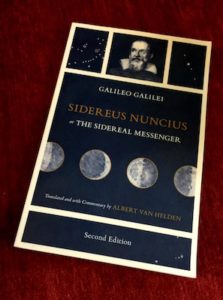My dear Galileo,
Each evening for weeks now I have carried my telescope to the top of a nearby hill and pointed its 70mm objective lens toward the clearly visible bright dot in the sky that I have learned to identify as Jupiter. Bringing it into focus, its 17.5x magnification – more than your early 8x model but less than your eventual 20x one – shows me clearly that what I am seeing is not a star but a planet; a planet with tiny illuminated dots seemingly nearby it.
Each night these dots, sometimes three, usually four, rarely two, appear in different positions relative to the planet on each night I observe them. I have not yet been able to discern a pattern to their changes in positions, nor have I yet been able to tell one from another – each appears the same size.
As I gaze up at this Jovian grouping each evening, I find myself asking the same question: “How did you do it?” How did you decide that what you were seeing were not background stars? How did you deduce that they were moons orbiting Jupiter, and how did you ever come to understand the patterns in which they were orbiting that planet?
 Then it came to me; you recorded what you observed and your interpretations thereof in a book – Sidereus Nuncius, or The Sidereal Messenger
Then it came to me; you recorded what you observed and your interpretations thereof in a book – Sidereus Nuncius, or The Sidereal Messenger. However as my Latin is not up to what it should be (who among us now can say that their own is), could I find a translation of your words into English? Not a commentary upon what you wrote, or selected bits of it, but your words themselves; the work in its entirety.
As it turned out, my friends at University of Chicago Press, long a source to which I have turned for scientific works from centuries past, did indeed have a translation of your book, taken directly from the original Latin of 1610 and rendered into English. A copy of this I have now obtained and into which I shall immediately be directing my attention. Therefore, I may now sign myself
Your enthusiastic reader and student,
Johannes
If you enjoyed reading this, please consider signing up for The Well-read Naturalist's newsletter. You'll receive a helpful list of recently published reviews, short essays, and notes about books in your e-mail inbox once each fortnight.
